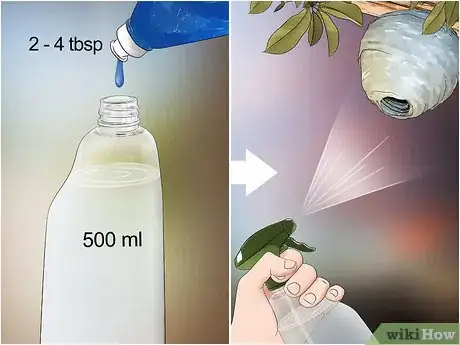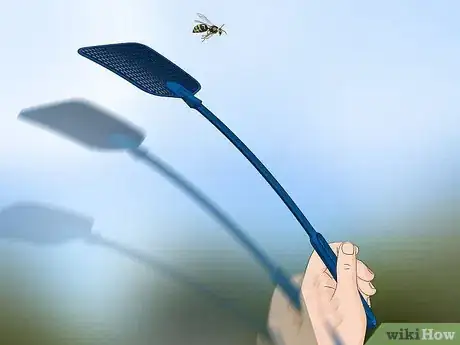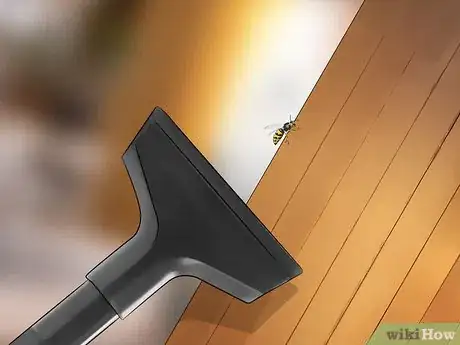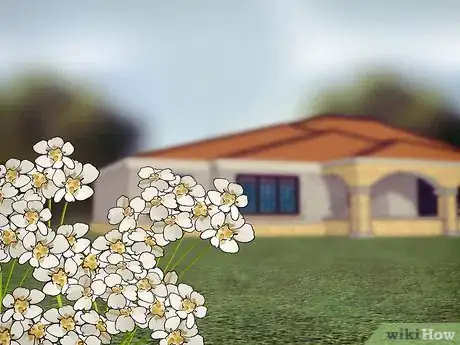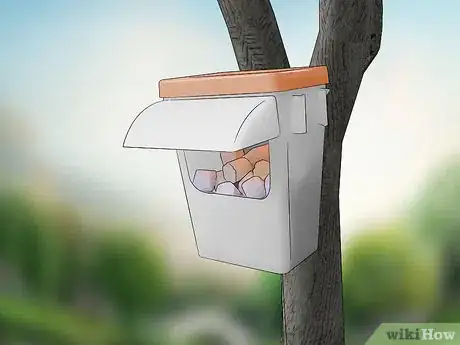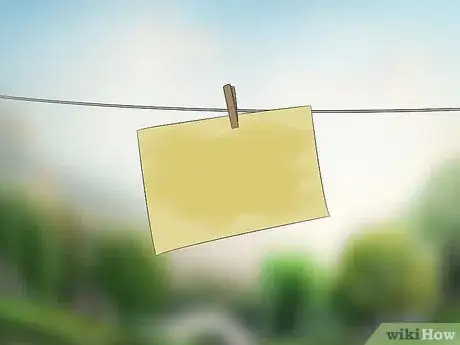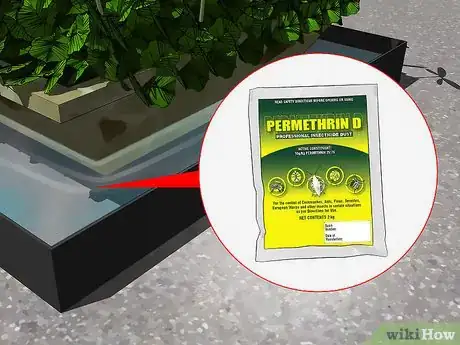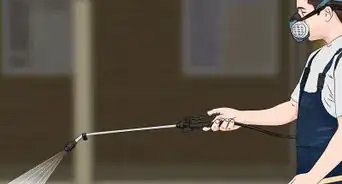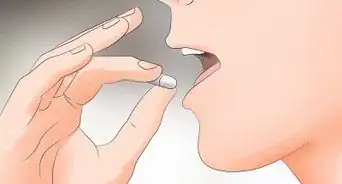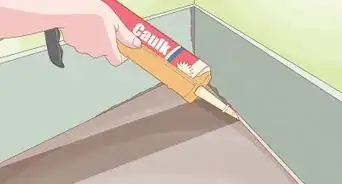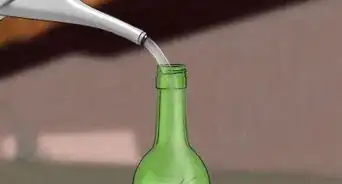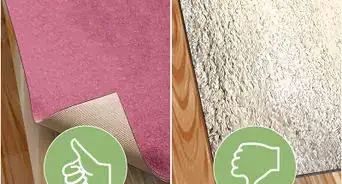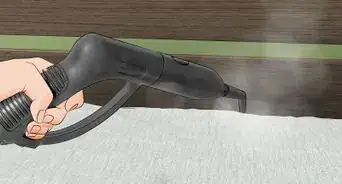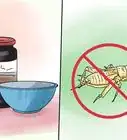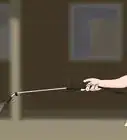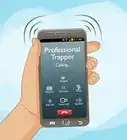This article was co-authored by Scott McCombe. Scott McCombe is the CEO of Summit Environmental Solutions (SES), a family-owned local pest solutions, animal control, and home insulation company based in Northern Virginia. Founded in 1991, SES has an A+ rating with the Better Business Bureau and has been awarded “Top Rated Professional,” and “Elite Service Award" by HomeAdvisor.
There are 11 references cited in this article, which can be found at the bottom of the page.
wikiHow marks an article as reader-approved once it receives enough positive feedback. In this case, 86% of readers who voted found the article helpful, earning it our reader-approved status.
This article has been viewed 853,390 times.
There are few worse things than stepping outside to enjoy the crisp backyard summer air and getting dive-bombed by a militant flying bug-missile with a stinger. Luckily, there’s no need to fight fire with fire — if you’ve got a wasp infestation, there are easy, natural ways to remove wasp colonies and prevent future nests. With our expert advice on getting rid of wasps and wasp nests, you’ll be back to enjoying a cool drink on the back patio in no time.
Steps
Using Traditional Wasp Control Methods
-
1Apply a mixture of 1 tablespoon (15 mL) peppermint oil with 16 ounces (473 mL) of water. Pour the water into a spray bottle and mix your peppermint oil in. Spray this solution on wasps and nests. Be sure to apply enough to soak the wasps and nests completely.[1] .
- Consider mixing 2 tablespoons (30 mL) of shampoo or dish soap in to help the peppermint stick to the application area and suffocate the wasps.
-
2Shoot a mixture of 1 tablespoon (15 mL) of dish soap per 1 cup (240 mL) of water. Pour hot water into a spray bottle and add your dish soap. Locate the wasps and spray them until they stop moving. If possible, use a hose-end sprayer for a more direct application. For larger nests, mix dish soap into your garden sprayer.
- Only spray nests at night and cover your light source with a cloth or use amber or red bulbs to prevent the wasps from attacking you.
Advertisement -
3Apply WD-40 around deck railings, window sills, and eaves. Wasps don't like the smell of WD-40, which makes it a great repellent. Apply 2 to 3 sprays around areas that you see wasps frequent, especially crevices or small areas that wasps would likely build a nest in. For nests, spray about 5 to 6 times or until its entire surface is covered.[2]
- Never spray near candles or a lit grill.
- Avoid burning the nest after spraying WD-40—this is extremely risky if you cannot control the flame.
-
4Apply insecticides on the nest, wasps, or areas where wasps frequent.[3] Read the label to determine the application rate, which will tell you how many gallons you need per acre or square foot. Mix 1 ounce (28 g) of product for every 1 gallon (3.8 L) of water. Spray the insecticide onto affected areas as early in summer as possible. Focus on enclosed spaces with closed windows and doors.[4]
- Apply insecticides directly to any individual wasps or to the entire nest, as directed.
- Work fast and try and apply the insecticide at night when the wasps are less active.
EXPERT TIPScott McCombe is the CEO of Summit Environmental Solutions (SES), a family-owned local pest solutions, animal control, and home insulation company based in Northern Virginia. Founded in 1991, SES has an A+ rating with the Better Business Bureau and has been awarded “Top Rated Professional,” and “Elite Service Award" by HomeAdvisor.Pest Control Specialist
 Scott McCombe
Scott McCombe
Pest Control SpecialistOur Expert Agrees: Wasps may be kept away by the regular, judicious use of pesticides labeled for wasps. Exclusion by foaming, caulking, and screening can also be very helpful indoors.
-
5Call a professional exterminator. If you're not confident using chemical insecticides or are having trouble getting rid of wasps on your own, professional exterminators might be a safer alternative. If you have a wasp nest in the walls of your home, an exterminator can drill a hole in the window frame, floor, or wall near the nest's location, and then pump insecticides through this hole to reach the nest.
- Hire a professional exterminator if you are on a limited timeframe—they have access to stronger chemicals, so the wasps might die more quickly.
Practicing Physical Wasp Removal
-
1Swat wasps using a flyswatter. The simplest, most direct way to kill a wasp is to smack it with a flyswatter. Wait until the wasp lands on a surface to rest. Swat it when it's motionless and continue to do so until it's dead. Only use a swatter if you are trying to get rid of one wasp or a small group in a concentrated area.
- Don't attempt to swat wasps if you have slow reflexes or haven't practiced swatting, as you are likely to get stung when the wasp flies away and tries to defend itself.
-
2Suck the wasps up using a powerful lightweight vacuum.[5] Turn on the vacuum and place it about 3 to 4 inches (7.6 to 10.2 cm) from the wasps. After you have vacuumed all the wasps, suck up 2 tablespoons (30 mL) of cornstarch to incapacitate them. Open the vacuum canister while it is still running, tape the opening of the bag, and then turn the vacuum off. Remove the bag and put it in a freezer overnight before throwing it away.[6]
- Choose a vacuum that has a removable bag.
- Vacuum wasps as spring arrives, right when they start coming out of hibernation. They tend to be slow and sluggish, making it easier to catch them and sweep them away.
-
3Hide appealing food sources. Flowers, food, and drinks can all attract wasps. Move flowers to the far side of your yard and be sure to clean up all food and drinks. At the end of the summer, wasps are most attracted to sugary drinks and foods. At the beginning and middle of the summer, they are more drawn to meat. Cover your food with resealable silicone lids, and avoid plastic and cling film.[7]
- Move potted flowers away from your house and avoid using sweet or floral perfumes, shampoos, lotions, or soaps.
- Do not let food linger outside, especially in the heat.
Baiting and Trapping Wasps
-
1Hang a lure trap along your property line within 1⁄4 mile (0.40 km) of wasps. Hang a commercially-bought lure trap in an area the wasps frequent.[8] Be sure to place it along your property line as far away from patios and protected areas as possible. Check every few days and replace it as needed once the trap begins to fill or after the time designated on the instructions.[9]
- Lure traps can be purchased from department stores, big-box stores, and online suppliers.
-
2Create a water trap using a 0.528 gallon (2.00 L) plastic bottle. Cut the neck off the plastic bottle. Remove the cap, turn the neck upside-down, and let it rest inside the opening. Place duct tape or packing tape horizontally along the connection point between the 2 bottle pieces. Afterward, fill the bottle with sugar water, soda, or pieces of meat and other protein. Hang it by taping strings to it or screwing a hole into it to affix it into wood.
- Wipe a layer of cooking oil around the edges of the trap so that it becomes too slippery for the wasps to stand on.
- Before emptying the trap, freeze it or pour boiling water into it to kill any remaining living wasps.
-
3Attach a bait station onto a close by post or tree trunk. A bait station is an enclosed trap that lures wandering wasps inside, at which point the wasps are killed with a chemical insecticide. Align button head self-tapping screws into the openings of each bait station. Place them against a tree or post near a wasps nest. Afterward, hammer the screws through the holes to affix them to the selected surface.
- Bait stations can be purchased form big-box stores or online suppliers.
-
4Set glue traps near wasp nests and entryways to the nests. Hang glue traps near wasp nests along clotheslines using clothespins. Glue traps can also be placed on flat surfaces in areas that wasps frequently crawl around.
- Use glue traps during the early stages of nest development, when the wasp population is smaller at this point and more easily controlled.
- Purchase glue traps from big-box stores and online suppliers.
-
5Make a drinking station bait with water and pyrethroid powder. Place a plant pot into a tray and fill the tray up with water. Put the pot in a sunny position and the wasps will eventually learn to drink there. Add a powder containing a pyrethroid such as permethrin (a natural product extracted from chrysanthemums). Mix the powder to a paste and stir water into it.
- Use drinking stations early in the summer for best results.
- Keep adding fresh water every 1 to 2 days to attract more wasps, and repeat the whole process every 3 to 5 days.
Getting Rid of Nests
-
1Hang a fake nest within 200 feet (61 m) of each new nest. Early on in the summer, you might be able to chase wasps away at their first appearance by hanging a fake nest around your home or around any area you want wasps to stay away from. However, this solution isn't always effective and doesn't work late in the summer.
- Purchase fake wasp nests from big-box stores and online suppliers. You can also use a paper lantern or brown paper bag.
-
2Knock the nest down after applying insecticide or early in the season. If you have applied insecticide or the season is early and the nest is still small, consider knocking the it down with a broom, rake, or other long-handled tools.[10]
- When the wasps are alive, you must knock the nest down on a regular basis to discourage the wasps. Expect to knock the nest down several times before the wasps give up and find somewhere else to build.
- If you have applied in insecticide and most of the wasps are dead, saturate it with insecticide spray after knocking it down and then break it apart.
-
3Drown underground nests with boiling water at night. Keep an eye on wasp behavior for 2 to 3 days and find the most frequented nest entrances and exits. Afterward, head over to these spots at night when the wasps are asleep and pour a pot of boiling water down. Stuff some soil into the holes after you have flooded the hive (unless the wasps begin to ascend from the nest).[11]
- Always wear protection and be careful—this method can trigger a mass attack.
-
4Capture and seal the nest in the fall. Wait until the coolest time of night and approach the nest as quietly as possible. Quickly slip a plastic bag over the nest while continuing to make as little noise as possible. Afterward, close the bag around the limb directly above the nest, tie the bag shut, and then break or cut the limb from the tree. Place the nest into the freezer for about a day or into a bucket of water to drown the wasps.[12]
- Only attempt to capture wasps in late October or after the first hard freeze, which is at least 4 hours in a row of air temperatures lower than 25 °F (−4 °C).
- Make sure the plastic has an airtight seal.
Expert Q&A
-
QuestionHow do you keep wasps away?
 Scott McCombeScott McCombe is the CEO of Summit Environmental Solutions (SES), a family-owned local pest solutions, animal control, and home insulation company based in Northern Virginia. Founded in 1991, SES has an A+ rating with the Better Business Bureau and has been awarded “Top Rated Professional,” and “Elite Service Award" by HomeAdvisor.
Scott McCombeScott McCombe is the CEO of Summit Environmental Solutions (SES), a family-owned local pest solutions, animal control, and home insulation company based in Northern Virginia. Founded in 1991, SES has an A+ rating with the Better Business Bureau and has been awarded “Top Rated Professional,” and “Elite Service Award" by HomeAdvisor.
Pest Control Specialist Regularly treat areas around your home with pesticides to deter wasps. If you have wasps getting into your home, seal any cracks or gaps where they may be coming in.
Regularly treat areas around your home with pesticides to deter wasps. If you have wasps getting into your home, seal any cracks or gaps where they may be coming in.
Warnings
- If you do not know whether you are allergic to wasp and bee stings, have an allergy test performed by your doctor before attempting to handle wasps directly.⧼thumbs_response⧽
- Do not try to get rid of the wasps yourself if you are allergic to wasp or bee venom or if the nest is in a spot that is difficult to access.⧼thumbs_response⧽
- Always wear protective gear when trying to get rid of wasps. Cover as much skin as possible, wear thick gloves and, if you can, a hat with a head net attached.⧼thumbs_response⧽
Things You'll Need
- Flyswatter
- Vacuum cleaner
- Broom
- Peppermint oil
- Water
- Spray bottle
- Dish soap
- WD-40
- Lure trap
- Sugar water or protein bait
- 0.528 gallons (2.00 L) plastic bottle
- Knife or scissors
- Plastic bag
- Cloth bag
- Tub of water
- Bait station
- Glue trap
- Rope
- Fake nest
- Chemical insecticide
- Protective clothing
References
- ↑ https://plantcaretoday.com/natural-ways-get-rid-wasps.html
- ↑ https://housewifehowtos.com/save-money/how-to-repel-wasps-naturally/
- ↑ Scott McCombe. Pest Control Specialist. Expert Interview. 19 November 2019.
- ↑ https://pesticidestewardship.org/homeowner/using-pesticides-safely-and-correctly/
- ↑ Scott McCombe. Pest Control Specialist. Expert Interview. 19 November 2019.
- ↑ https://www.beyondpesticides.org/assets/media/documents/alternatives/factsheets/Wasp%20Control2.pdf
- ↑ https://www.countryliving.com/uk/wildlife/countryside/a22711271/how-to-keep-wasps-away-from-picnic-food/
- ↑ Scott McCombe. Pest Control Specialist. Expert Interview. 19 November 2019.
- ↑ http://www.ipm.ucdavis.edu/PMG/PESTNOTES/pn7450.html
About This Article
To get rid of wasps in your home or around your house, start by physically removing them. If there’s a wasp within a few inches of you, try using a flyswatter to smack and kill it. You can also use a vacuum to suck up slow-moving wasps that are crawling on the ground, or brush them away with a broom. For wasps that have built nests, consider placing bait traps, glue traps, or drinking traps outside to kill them. If the wasps won’t go away, consider using insecticides or hiring an exterminator to get rid of them. If you want to learn how to take down a wasp nest from an eave or tree, keep reading the article!

